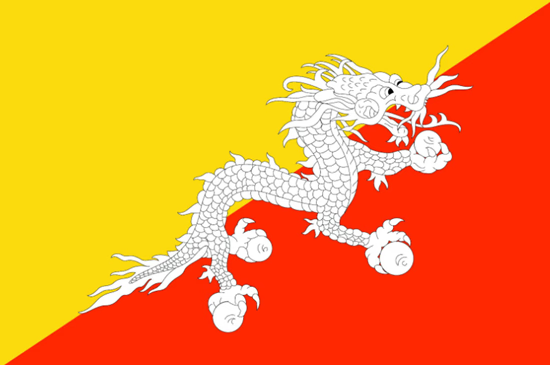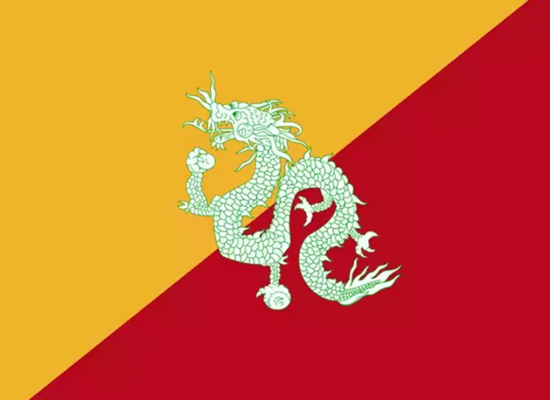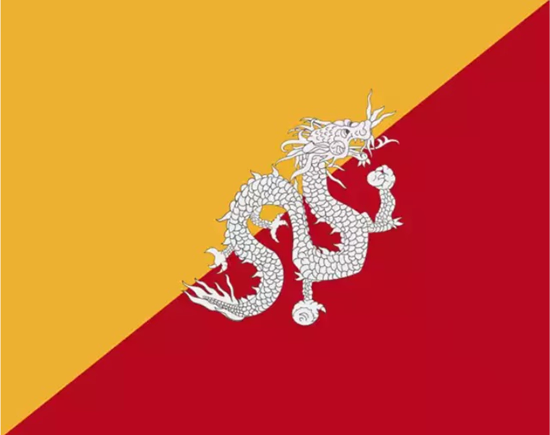
The Bhutan flag is more than just a fabric; it’s a vibrant symbol of the nation’s identity and heritage. The national flag of Bhutan embodies the rich history and cultural significance of this small Himalayan kingdom.
As travelers prepare to explore Bhutan, understanding the meaning behind its flag can deepen their appreciation for the country's unique traditions and values.
Join us on this journey to discover how Bhutan's national flag reflects the spirit of its people and why it’s an essential part of your travel experience.
History And Evolution Of The National Flag Of Bhutan
According to The Centre for Bhutan Studies, this is how the national flag of Bhutan was made:
First Version (1949)
 Image Credit: Flagmakers.co.uk
Image Credit: Flagmakers.co.uk
The national flag of Bhutan was first introduced in 1949 during the signing of the Indo-Bhutan Treaty, initiated by His Majesty Jigme Wangchuck. The design of this original Bhutan flag was a square flag divided diagonally into yellow and red fields, featuring a green dragon at the center, facing the fly end.
Lharip Taw Taw, a court painter, embroidered the dragon. Although this flag was used exclusively for the treaty signing, a version is displayed in the National Assembly Hall in Thimphu.
Second Version (1956)
 Image Credit: Flagmakers.co.uk
Image Credit: Flagmakers.co.uk
The second version of the flag emerged during the late King Jigme Dorji Wangchuck’s visit to eastern Bhutan in 1956. Officials from the late King's Secretariat created Bhutan’s old flag based on a photograph of the first version. Notably, the dragon's color was changed to white.
During the journey, small flags were affixed to the saddles of every tenth pony in the convoy, while a larger flag was displayed at the camp, showcasing the flag's growing significance.
Present National Flag
The current Bhutan flag, established in the late 1950s, was redesigned following observations that a square flag did not flutter as well as a rectangular one. The new flag measures nine by six feet and features a white dragon embroidered diagonally along a yellow and orange bicolor design.
This version retains the white dragon, which is now depicted clutching jewels, symbolizing Bhutan's wealth and prosperity. The contemporary design reflects the nation's identity and serves as a proud emblem of national unity.
Each iteration of the flag represents a pivotal moment in Bhutan's flag history, highlighting its cultural heritage and significance for the nation.
 Image Credit: Freepik
Image Credit: Freepik
Meaning And Symbolism Of The Flag Of Bhutan
The national flag of Bhutan holds profound meaning. It represents the Kingdom's independence and sovereignty. It serves as a symbol of honor and the complete victory of the state in all directions.
The flag is prominently displayed during visits from heads of state and various national celebrations, reflecting its significance in Bhutanese culture and identity.
Yellow Half: The upper half of the flag is yellow, symbolizing civil tradition and embodying the essence of His Majesty the King. It represents the foundation of monastic and civil traditions, highlighting the King’s role in upholding and enhancing the limits of his reign.
Orange Half: The lower half of the flag is orange, signifying the monastic tradition rooted in the teachings of Buddha. This section reflects the harmonious coexistence of the Kagyud and Nyingma traditions, representing Bhutan's cultural heritage's spiritual depth and richness.
The Dragon: The dragon stretches across the flag, symbolizing the Kingdom of Druk. Its presence signifies the integration of monastic and civil traditions, embodying the nation's unity and strength.
White Dragon: The dragon is depicted in white, symbolizing the purity of thought and deed among the diverse peoples of the Kingdom. Despite their differences in conduct, the shared values of patriotism and loyalty create an untainted bond between the sovereign and the people, reinforcing Bhutan's collective identity.
Physical Characteristics Of The National Flag
The national flag of Bhutan is a rectangular banner characterized by its vibrant yellow and orange background. The flag’s design features a prominent white dragon, the Druk, positioned at the center.
The dragon is depicted in a dynamic motion, with its body gracefully extending across the boundary that separates the yellow and orange segments.
The flag's proportions are 3:2, ensuring a harmonious and balanced appearance. The approved dimensions for the national flag vary, including sizes of 21 by 14 feet, 12 by 8 feet, 6 by 4 feet, 3 by 2 feet, and 9 by 6 inches.
These dimensions accommodate different uses and occasions, allowing the flag to be displayed prominently during state functions and celebrations.
The striking colors and intricate design of the flag represent Bhutan’s cultural heritage and serve as a source of national pride, symbolizing the kingdom's unity and identity.
National Flag Rules And Regulations
The national flag of Bhutan is not only a symbol of the Kingdom's identity but also a representation of its dignity and respect. To uphold this significance, the National Assembly of Bhutan established a code of conduct in 1972, formalizing the flag's design and outlining its display and usage protocols.
Height Requirement: The national flag should be flown at a minimum height of 10 feet above the ground. This elevation ensures the flag is prominently visible and maintains its dignified presence.
Respectful Display: The flag must be displayed respectfully, with the hoist side facing the viewer. This positioning signifies honor and respect for the nation's emblem.
Condition of the Flag: It is imperative that the flag not be flown when it is damaged or worn out. Maintaining the flag in good condition reflects the reverence held for this national symbol and upholds the dignity of the Kingdom.
Conclusion About The Bhutan Flag
The flag of Bhutan is a profound symbol of the nation’s sovereignty, cultural heritage, and people's unity.
With its striking design and rich symbolism, the flag embodies the values that define Bhutanese identity. As you explore this beautiful Kingdom, understanding the significance of its flag enhances your appreciation for its unique culture and traditions.
For an unforgettable journey through Bhutan, trust Druk Asia, the top Bhutan tour agency. Let us help you uncover the wonders of this remarkable land—book your adventure today!
Frequently Asked Questions About The Bhutan Flag
What Is The National Emblem Featured On The Bhutanese Flag?
The national emblem of Bhutan, represented by a white dragon, is a key feature of the Bhutanese flag. It symbolizes the Kingdom of Bhutan’s rich cultural heritage and the unity of its people.
What Do The Colors Of The Bhutanese Flag Represent?
The yellow half of the flag signifies civil tradition and the authority of the Dragon King, while the orange half represents monastic tradition and the teachings of Buddha. Together, they embody the values of the Kingdom of Bhutan.
Why Is The Flag Often Referred To As The Flag Of The Country Or Dragon Kingdom?
Bhutan is commonly known as the "Dragon Kingdom" due to the dragon or Druk featured on the flag. This reflects the country’s deep-rooted cultural identity and its connection to the mythical dragon in Bhutanese folklore.
What Is Located At The Center Of The Flag?
The flag's center features the white dragon, which stretches across the boundary between the yellow and orange segments. This central placement underscores the dragon's importance in representing the Kingdom of Bhutan.
Who Is The Dragon King In Bhutanese Culture?
The Dragon King refers to the reigning monarch of Bhutan, who plays a significant role in the country’s history and identity. The flag's dragon symbolizes his authority and the harmony between the monarchy and the Bhutanese people.
